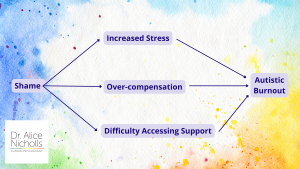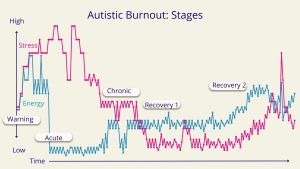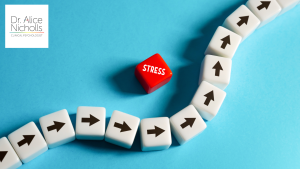Energy Accounting, originally developed by Autistic Clinical Psychologist Maja Toudal, is a way of viewing energy as a limited resource you can budget for in the same way you would money. It is popular in the chronic health conditions communities but it can also be a useful tool in Autistic Burnout.
In this article I will cover:
- What Energy Accounting is
- How Energy Accounting can be applied to Autistic Burnout
- How to adapt Energy Accounting for use in Autistic Burnout
- How you can use Energy Accounting to help you to recover from Autistic Burnout
What is Energy Accounting?
Energy accounting is a way of measuring how much energy you have and how much set tasks and stressors will cost you in energy.
It is sometimes called ‘spoon theory’ which was created by Christine Miserandino (https://butyoudontlooksick.com) to help people living with chronic illness. She describes people having a set number or ‘spoons’ worth of energy that is unique to them and their situation. Some tasks use more spoons than others depending on the person. For example, someone in chronic pain might start the day off with 15 spoons of energy but spend 5 of them just getting washed and dressed. People with limited energy often find this a helpful way of visualising their energy levels and sometimes refer to themselves as ‘spoonies’.
You can measure your energy any way you like, if spoons work for you, then go with it. I quite like using a battery analogy, a bit like in video games, where your energy levels are represented by a battery power level. My children like to use the idea of ‘beans’ they often start the day with hundreds but realise they’ve used them all up when we have to walk home from the park.
The idea behind Energy Accounting is that you start to notice your energy levels and how that energy is spent each day. It can also help to notice when and where you are gaining energy.
By tracking your energy budget and expenditure you can start to get a sense of how much energy certain tasks are going to cost you in advance and plan for that ‘spending’ by budgeting your energy throughout the day or week.
If we follow the theory through, it makes sense to build up some reserves for hard times, so ending each day, or as many as possible, with a little bit of energy left.
How does Energy Accounting Apply to Autistic Burnout?
In Autistic Burnout people have often been using up all of their energy, and running in a deficit or debt overall for a long time. When this is the case, what we need is a period of time with a significantly reduced daily spend, to get out of debt and to start to build up some reserves for the future.
When we are in Autistic Burnout we don’t start the day at 100% sometimes we don’t even start the day at 10% , so starting to build up reserves can be really difficult.
Likewise, because stress has often been chronic, we can’t always identify why we are waking up with 15% battery power. So, although it can be useful to look for patterns between events of the previous day and the energy levels you are waking with, there might not always be a clear reason.
On days where we find ourselves with a higher battery power than usual, we might feel compelled to use it all up. Making the most of the energy while we have it. we might also find it difficult to stop a task once we have started it, even though we know we are pushing ourselves into energy-debt. This pattern perpetuates the burnout cycle.
We can use energy accounting as a rationale for reducing energy expenditure. Knowing that we need to get out of energy ‘debt’ I usually suggest my clients try to leave themselves with 20-40% of what they started the day with, wherever possible.
How can Energy Accounting be Adapted for Autistic Burnout?
Because alot of the resources on energy accounting have come out of the chronic physical health conditions literature there is a focus on physical energy.
In order to make Energy Accounting relevant to Autistic Burnout we need to think more about different types of energy.
You might have noticed that on some days you can’t face talking to anyone, but you can concentrate on a book or do an exercise routine. likewise, somedays you might feel so physically tired you can’t get out of bed but also feel lonely and want some social interaction.
Years ago, when I had two young children I used to feel totally socially and cognitively exhausted by the weekend. I wanted to go to bed and stay there, but there was housework to do. I made a deal with my partner that they would look after the children on Saturday mornings while I cleaned the whole house. I noticed how, although I wasn’t resting, I felt replenished by this activity. I was moving my body and doing tasks I didn’t need to think about and I wasn’t having to talk to anyone.
The example above (from my own personal experience) illustrates that we can be resting and replenishing one supply of energy while using up another.
The benefit of this realisation is that we are able to make decisions about our activities that take into account our different energy levels.
It can feel hard to justify spending time doing an exercise class when you are too exhausted to go to work or look after the children. Equally, it can feel disengenious to write blog posts when you haven’t responded to text messages from friends.
Understanding that you have different types of energy and that these can be depleted to different extents can help to:
- Plan activities that make the best use of the energy you have.
- Give yourself permission to do something you want to do, despite being exhausted by one type of activity.
- Find more ways of recharging your different energy levels throughout your day.
- Communicate your needs to others in a way they can understand.
Noticing different types of energy can be hard for Autistic People, especially if you have difficulties with interception. Simply being asked to rate your energy levels on a scale of 0-10 can feel overwhelmingly complicated.
A big part of energy accounting work in Autistic Burnout is on finding ways to define your energy levels that work for you.
How can I use Energy Accounting to Help me Recover from Autistic Burnout?
- Qualify your different categories of energy
- Quantify your different levels of energy
- Track your energy levels
- Budget for energy spending
- Start to build up energy ‘savings’
Qualify your different categories of energy
First of all, it is helpful to think about which categories of energy you are, or could be aware of. Think of your activities during a typical day and ask yourself which ones have a similar effect on you? which ones would feel overwhelming if they immediately followed each other? Which ones seem to feel easier if they follow on from each other?
You may find it helpful to keep notes on how you feel after each activity for a few days to help you to identify your different types of energy.
For the purposes of this article I have made three categories of energy:
- Physical
- Social
- Cognitive
You might find it helpful to add further categories such as sensory or emotional when thinking about your energy levels.
Physical energy
Physical energy is any type of energy that you need to move your body or complete physical tasks. I tend to include stimulation seeking and sensory regulation in this category.
Social energy
Social energy is the energy we use when we are around other people, being exposed to social demands, even if it’s just being in the presence of someone or responding to a text message.
Cognitive energy
Cognitive energy is any energy used for thinking, planning, organising or processing information. I include executive functioning skills and emotional regulation in this category but as always, things don’t always fit neatly into either category so feel free to put things where they fit best for you or add more categories to suit your experience of energy.
Quantify your different levels of energy
Once you have an idea of which categories of energy you experience you can start to think about how you feel with different levels of that energy.
For each energy type ask yourself one or more of the following questions:
- How do I feel when I’ve got 100%, 50% and 0%?
- How do I act when I’ve got 100%, 50% and 0%?
- What do other people notice about me (you could ask them) when I’ve got 100%, 50% and 0%?
- What do I want to do when I’ve got 100%, 50% and 0%?
You are likely to find some of the questions above easier than others to answer, that’s okay, chose which ever question is easiest for you to answer and work on that. I have provided an example below for you to refer to.
| Physical | Social | Cognitive | |
| 0% | V hard to get out of bed Simple movements feel strenuous Don’t want to eat | Don’t want to see or talk to anyone Avoid social media Avoid messages | Can’t work out how to do basic tasks Upset by change Can’t concentrate on anything No problem solving skills |
| 50% | Normal movement is effortless Want to do a limited amount of light exercise Feel regulated | Enjoy spending time with close friends Need time alone too Enjoy limited amount of social media | Need routine limited problem solving skills Concentration dependent on level of interest |
| 100% | Want to do intense exercise Feel agitated if not moving Could keep going for hours | Interested in meeting new people Happy to spend all day with close others Lonely if alone | Good problem solving skills Confident making decisions Want to learn |
Track your energy levels
When you have an idea of how you are measuring your energy levels and what a low, mid and high level looks, feels or acts like you can start to track your energy levels throughout the day.
You could keep a diary of your energy levels throughout the day, checking in with yourself during and/or after activities.
You will start to notice fluctuations in your energy levels. If you are deep in Autistic Burnout, these fluctuations might be very small. Even the smallest fluctuations are useful information. You will start to build up an idea of the energy costs and benefits of different activities.
Budget for energy spending
Using the data from tracking your energy levels before and after activities you can start to predict how much energy certain tasks and situations will cost or gain for you.
You might find it helpful to measure your energy levels at the beginning of the day and plan for how you will spend, or save it.
If you can see you are at risk of running into a deficit, try to introduce activities or rest periods that help to replenish your energy levels. If an activity is not essential and it is going to cost you too much energy, consider cancelling, postponing or reducing the intensity or duration of it.
Aim to schedule your planned activities so that you are leaving yourself 20-40% of whatever you started the day with. Over time this will help to start to build up some reserves for the future.
“Sometimes a change is as good as a rest….and sometimes it really isn’t”
Dr Alice Nicholls, Clinical Psychologist
Please note that If you are in Autistic Burnout, you may be starting the day with very little, or no energy at all. If this is the case, it might not always be possible to save energy for another day. This is really hard. If you have no choice but to overspend your energy levels a more realistic target might be to overspend by as little as possible. Please try to be kind to yourself about this. Sometimes our stressors are outside of our control or are not easily controlled. If this is the case for you, then making yourself more aware of your energy levels, reducing spending where you can and thinking about what you need for the future will still help you to plan your recovery from Autistic Burnout.
Making, even the smallest steps, towards a more sustainable lifestyle can help to increase feelings of hope and reduce overwhelm.
I am an Autistic Clinical Psychologist specialising in Autistic Burnout if you would like to know more about my work please check out my:
- Mailing list community for people who want to receive helpful information and resources about Autistic Burnout.
- Free short course on How to Break the Cycle of Autistic Burnout (link goes straight to registration page)
- Authenticity Basecamp: A 90 day support programme for people in the early stages of recovering from Autistic Burnout who want to get calmer, clearer and more supported.
- Authenticity: The Course and Community: For late-realised, high-masking Autistic adults who want to build more sustainable, authentic lives and break free of the cycle of Autistic Burnout for good.











